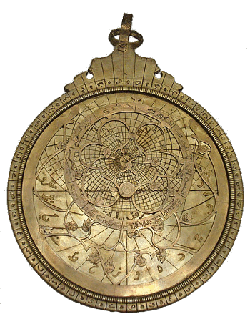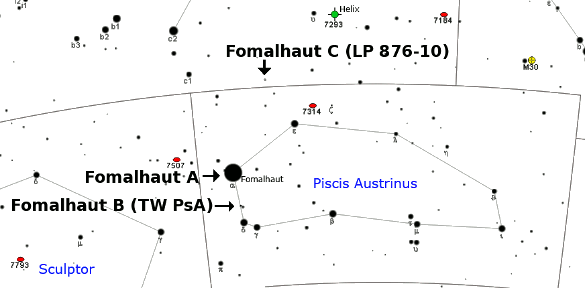The Fomalhaut Triplet
October 18, 2013

Astronomy
flourished in the medieval Arabic world; and, for that reason, quite a few stars retain Arabic names. The more common ones are listed below, "more common" being the ones that are familiar to an armchair astronomer like me.
Left, a modern Persian astrolabe from Wikimedia Commons. Astrolabes were common devices in the Islamic world, since they were used to find the Qibla; that is, the direction to Mecca.
![]()
Although Fomalhaut is a bright
star with an
apparent magnitude of -1.16, it's not often observed by
amateur astronomers in the
Northern Hemisphere because of its location on the
celestial sphere. Fomalhaut is in the constellation,
Piscis Austrinus, which, as its name ("the southern fish") indicates, is a
southern constellation. Fomalhaut has a
declination of −29° 37' 20.050", so it's very low in the southern skies of
North America, and it can't be seen at all in some
months of the
year.
Recently, Fomalhaut, which is just 25
light years from Earth, has had considerable
press. In 2008, it was the first star system for which an
extrasolar planet, named
Fomalhaut b, was imaged at
visible wavelengths.[1-2] Now, it's been discovered that Fomalhaut, more precisely called Fomalhaut A since it's part of a
binary star system with
TW Piscis Austrini (Fomalhaut B), is actually part of a
triple star system.[3-5]

Artist's conception of the extrasolar planet, Fomalhaut b, orbiting in a debris disk around its star,
Fomalhaut A.
(NASA/Space Telescope Science Institute image by L. Calcada, via Wikimedia Commons.)
The star,
LP 876-10, wasn't discovered until 1980, and now it's found to be the third star of the Fomalhaut system, so it's Fomalhaut C. This discovery was long in coming, since LP 876-10 is 2.5 light years from Fomalhaut A and 3.2 light years from Fomalhaut B. For comparison, a third star,
Proxima Centauri, presumed to be associated with the binary members of the
Alpha Centauri star system is only 0.2 light years from its companion stars. Fomalhaut A is an
A-class star, Fomalhaut B is a
K-class star, and Fomalhaut C is an
M4-class red dwarf star.

Star map of the region around Fomalhaut A and its companion stars, Fomalhaut B, and the newly discovered Fomalhaut C. (Base star map by Roberto Mura.)[6)]
This discovery, accepted for publication in
The Astronomical Journal, was made by a huge international
collaboration of astronomers from the
United States,
Chile and the
Netherlands. The team was led by
Eric E. Mamajek of the
Department of Physics and Astronomy of the
University of Rochester (Rochester, New York). The team's
astrometry,
radial velocity, and
photometric data for LP 876-10 were consistent with its being a third component to the Fomalhaut system
This was a surprising result, since LP 876-10, now Fomalhaut C, is about 5.5
degrees away from Fomalhaut A. This separation, 0.77
parsec from Fomalhaut A and 0.987 parsec from Fomalhaut B, is still within the estimated 1.9 parsec
gravitational radius of the Fomalhaut system. Not only that, but the motion of Fomalhaut C is within a
kilometer/sec of its companions.[3]
Careful observation is a requisite for good
science, and the discovery of Fomalhaut C is a good example. Says Mamajek
"I noticed this third star a couple of years ago when I was plotting the motions of stars in the vicinity of Fomalhaut for another study... However I needed to collect more data and gather a team of co-authors with different observations to test whether the star's properties are consistent with being a third member of the Fomalhaut system."[4]
One key to the discovery was knowledge of the actual distance of LP 876-10. As even a layman knows, a close separation of stars on the celestial sphere is no indication of the actual distance between the stars; and, in this case, the large angular separation of LP 876-10 from Fomalhaut A and Fomalhaut B masked its actual proximity.
Jennifer Bartlett, while working on her
Ph.D. thesis at the
University of Virginia, had just measured the
parallax of the star, so its distance was known.[4] Fomalhaut C may have
evolved close to its companions, and it was then pulled out of the system by an interloper. However, this is not likely to have been the case, since the planetary system of Fomalhaut A would have been disrupted.
Triple star systems are actually quite common. There are eleven such systems closer to Earth than Fomalhaut, including Alpha Centauri, as mentioned above. Fomalhaut appears in the
science fiction novels of
Isaac Asimov,
Stanislaw Lem,
Philip K. Dick, and
Frank Herbert.[4]
References:
- Paul Kalas, James R. Graham, Eugene Chiang, Michael P. Fitzgerald, Mark Clampin, Edwin S. Kite, Karl Stapelfeldt, Christian Marois and John Krist, "Optical Images of an Exosolar Planet 25 Light-Years from Earth," Science, vol. 322, no. 5906 (November 28, 2008), pp. 345-1348.
- Paul Kalas, James R. Graham, Eugene Chiang, Michael P. Fitzgerald, Mark Clampin, Edwin S. Kite, Karl Stapelfeldt, Christian Marois and John Krist, "Optical Images of an Exosolar Planet 25 Light Years from Earth," arXiv Preprint Server, November 19, 2008.
- Eric E. Mamajek, Jennifer L. Bartlett, Andreas Seifahrt, Todd J. Henry, Sergio B. Dieterich, John C. Lurie, Matthew A. Kenworthy, Wei-Chun Jao, Adric R. Riedel, John P. Subasavage, Jennifer G. Winters, Charlie T. Finch, Philip A. Ianna and Jacob Bean, "The Solar Neighborhood XXX: Fomalhaut C," arXiv Preprint Server, October 2, 2013.
- Researchers Find that Bright Nearby Double Star Fomalhaut Is Actually a Triple, University of Rochester Press Release, October 3, 2013.
- Monica Young, "Fomalhaut Star System Actually a Triple," Sky and Telescope, October 7, 2013.
- Data page for Fomalhaut C = LP 876-10, University of Rochester.
Permanent Link to this article
Linked Keywords: Astronomy in medieval Islam; medieval Arabic world; list of Arabic star names; armchair astronomer; Persian; astrolabe; Wikimedia Commons; Islamic world; Qibla; Mecca; Aldebaran; Pleiades; Algol; Ghoul; Altair; Eagle; Betelgeuse; Armpit; Orion constellation; Central One; Deneb; Fowl; Fomalhaut; Piscis Austrinus; Southern Fish; Mizar; Apron; Rigel; Foot; Vega; star; apparent magnitude; amateur astronomy; amateur astronomer; Northern Hemisphere; celestial sphere; southern constellation; declination; North America; month; year; light year; press; extrasolar planet; Fomalhaut b; visible spectrum; visible wavelength; binary star system; TW Piscis Austrini; triple star system; debris disk; NASA; Space Telescope Science Institute; LP 876-10; Proxima Centauri; Alpha Centauri; Stellar classification; A-class; K-class; M4-class; red dwarf star; Roberto Mura; The Astronomical Journal; collaboration; United States; Chile; Netherlands; Eric E. Mamajek; Department of Physics and Astronomy; University of Rochester (Rochester, New York); astrometry; radial velocity; photometry; data; degree; parsec; Roche lobe; gravitational radius; kilometer/sec; science; Jennifer Bartlett; Doctor of Philosophy; Ph.D.; thesis; University of Virginia; parallax; stellar evolution; science fiction; novel; Isaac Asimov; Stanislaw Lem; Philip K. Dick; Frank Herbert.